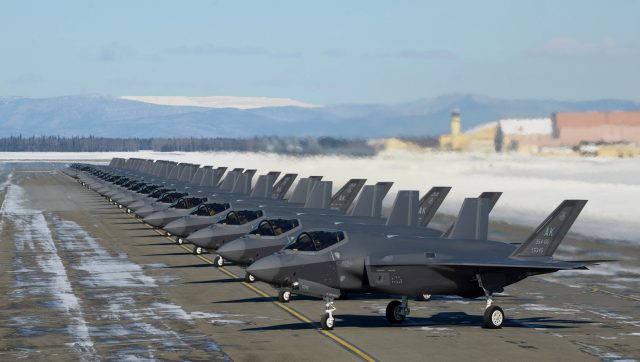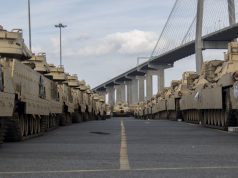
The world set a record for military spending in a year, reaching $2113 billion in 2021, data on global military spending published by the Stockholm International Peace Research Institute (SIPRI) shows.
To reach the two trillion mark, total global military expenditure increased by 0.7 per cent in real terms in 2021, with the United States, China, India, the United Kingdom and Russia being the five largest spenders in 2021. These countries together accounted for 62 per cent of expenditure.
This was the seventh consecutive year that spending increased, according to SIPRI.
“Even amid the economic fallout of the Covid-19 pandemic, world military spending hit record levels,” said Dr Diego Lopes da Silva, senior researcher with SIPRI’s Military Expenditure and Arms Production Program.
“There was a slowdown in the rate of real-terms growth due to inflation. In nominal terms, however, military spending grew by 6.1 per cent.”
As a result of a sharp economic recovery in 2021, the global military burden—world military expenditure as a share of world gross domestic product (GDP)—fell by 0.1 percentage points, from 2.3 per cent in 2020 to 2.2 per cent in 2021.
The global military spending leader remained the United States, with $801 billion spent in 2021, a drop of 1.4 per cent from 2020. The US military burden decreased slightly from 3.7 per cent of GDP in 2020 to 3.5 per cent in 2021.
SIPRI data shows US funding for military research and development (R&D) rose by 24 per cent between 2012 and 2021, while arms procurement funding fell by 6.4 per cent over the same period. In 2021 spending on both decreased. However, the drop in R&D spending (–1.2 per cent) was smaller than that in arms procurement spending (–5.4 per cent).
“The increase in R&D spending over the decade 2012–21 suggests that the United States is focusing more on next-generation technologies,” said Alexandra Marksteiner, researcher with SIPRI’s Military Expenditure and Arms Production Program.
“The US Government has repeatedly stressed the need to preserve the US military’s technological edge over strategic competitors.”
Russia increased its military budget in run-up to war
Russia increased its military expenditure by 2.9 per cent in 2021, to $65.9 billion, at a time when it was building up its forces along the Ukrainian border.
This was the third consecutive year of growth and Russia’s military spending reached 4.1 per cent of GDP in 2021.
“High oil and gas revenues helped Russia to boost its military spending in 2021. Russian military expenditure had been in decline between 2016 and 2019 as a result of low energy prices combined with sanctions in response to Russia’s annexation of Crimea in 2014,” said Lucie Béraud-Sudreau, Director of SIPRI’s Military Expenditure and Arms Production Program.
The national defense budget line, which accounts for around three-quarters of Russia’s total military spending and includes funding for operational costs as well as arms procurement, was revised upwards over the course of the year. The final figure was $48.4 billion, 14 per cent higher than had been budgeted at the end of 2020.
As it has strengthened its defences against Russia, Ukraine’s military spending has risen by 72 per cent since the annexation of Crimea in 2014. Spending fell in 2021, to $5.9 billion, but still accounted for 3.2 per cent of the country’s GDP.
China, the world’s second largest spender, allocated an estimated $293 billion to its military in 2021, an increase of 4.7 per cent compared with 2020. China’s military spending has grown for 27 consecutive years. The 2021 Chinese budget was the first under the 14th Five-Year Plan, which runs until 2025.
Following initial approval of its 2021 budget, the Japanese government added $7.0 billion to military spending. As a result, spending rose by 7.3 per cent, to $54.1 billion in 2021, the highest annual increase since 1972.
Australian military spending also increased in 2021: by 4.0 per cent, to reach $31.8 billion.
“China’s growing assertiveness in and around the South and the East China seas have become a major driver of military spending in countries such as Australia and Japan,” said SIPRI senior researcher Dr Nan Tian.
“An example is the AUKUS trilateral security agreement between Australia, the United Kingdom and the United States that foresees the supply of eight nuclear-powered submarines to Australia at an estimated cost of up to $128 billion.”
In 2021 Iran’s military budget increased for the first time in four years, to $24.6 billion. Funding for the Islamic Revolutionary Guard Corps continued to grow in 2021—by 14 per cent compared with 2020—and accounted for 34 per cent of Iran’s total military spending.
NATO member spending
Eight European North Atlantic Treaty Organization (NATO) members reached the alliance’s target of spending 2 per cent or more of GDP on their armed forces in 2021. This is one fewer than in 2020 but up from two in 2014.
Germany—the third largest spender in Central and Western Europe—spent $56.0 billion on its military in 2021, or 1.3 per cent of its GDP. Military spending was 1.4 per cent lower compared with 2020 due to inflation.
French military expenditure reached $56.6 billion in 2021, 1.5 per cent higher than in 2020 and 13 per cent higher than in 2012. France spent the equivalent of 1.9 per cent of its GDP on the military in 2021. The allocation was in line with France’s 2019–25 Military Programming Law. The government initially planned to update the legislation in 2021, but this was postponed due to the financial uncertainty caused by the Covid-19 pandemic.
Total military spending in Europe in 2021 amounted to $418 billion, 3.0 per cent higher than in 2020 and 19 per cent higher than in 2012. The aggregated military spending of Central and Western Europe—two subregions that together include most NATO allies and all European Union member states—totalled $342 billion in 2021 ($305 billion for Western Europe and $36.6 billion for Central Europe). The combined military expenditure of these subregions increased by 3.1 per cent in 2021. Military spending in Western Europe grew at a higher rate (3.4 per cent) than in Central Europe (1.3 per cent). The growth in military spending in Central and Western Europe was mostly driven by increased expenditure on arms procurement and military R&D.
In 2021 Qatar’s military spending was $11.6 billion, making it the fifth largest spender in the Middle East. Qatar’s military spending in 2021 was 434 per cent higher than in 2010, when the country last released spending data before 2021. India’s military spending of $76.6 billion ranked third highest in the world. This was up by 0.9 per cent from 2020 and by 33 per cent from 2012. In a push to strengthen the indigenous arms industry, 64 per cent of capital outlays in the military budget of 2021 were earmarked for acquisitions of domestically produced arms.
Nigeria raised its military spending by 56 per cent in 2021, to reach $4.5 billion. The rise came in response to numerous security challenges such as violent extremism and separatist insurgencies.
Shakeup in the top 15 military spenders ranking
Military spending by the top 15 countries reached $1717 billion in 2021, accounting for 81 per cent of global military expenditure (see table 1). The US (accounting for 38 per cent of world military spending in 2021) and China (14 per cent) remained by far the two largest spenders.
There were, however, some notable changes in ranking among the top 15 between 2020 and 2021, SIPRI noted. The UK and France each moved up two ranks, becoming the fourth and sixth largest spenders in 2021, respectively. After a 17 per cent drop in its military spending, Saudi Arabia fell from fourth largest spender in 2020 to eighth largest in 2021. Iran increased its military spending by 11 per cent, making it the 14th largest military spender in 2021. This is the first time in 20 years that Iran has ranked among the top 15 military spenders.
For the full SIPRI report and figures, follow this link

























